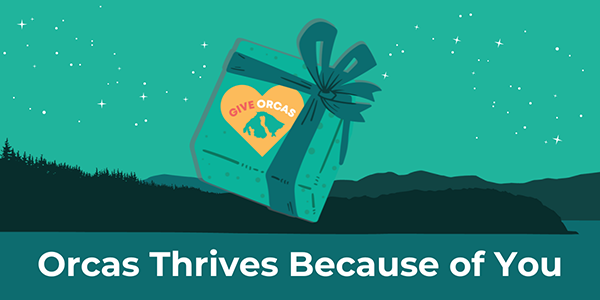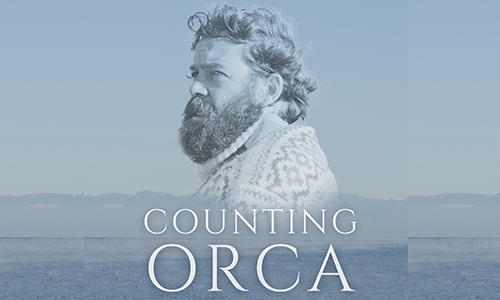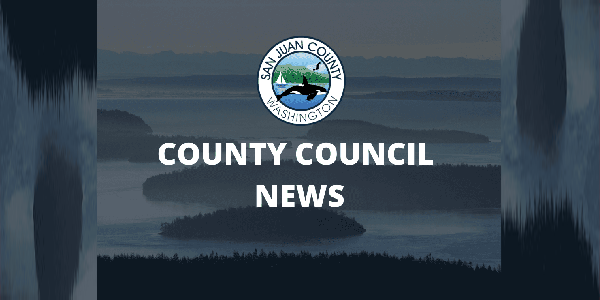— by Matthew Gilbert, Orcas Issues reporter —
Dying orcas. Decimated salmon runs. Endangered abalone. The signs of decline are everywhere and accelerating as the Salish Sea fights for its life against the relentless forces of human impact and regulatory inertia.
On December 5 a group of about 50 Orcas Islanders gathered in a circle at Emmanuel Parish Hall to share their feelings and ideas in a wide-ranging discussion on what it would it mean to establish “rights for nature” and, more specifically, rights for the Salish Sea. The event was hosted by Community Rights San Juan Islands (CRSJI), a tiny nonprofit based on Lopez Island. The featured guest was Kai Huschke, a regional organizer from the Community Environmental Legal Defense Fund (CELDF) in Mercersburg, PA, that focuses on rights of nature and the right to local self-government. It was the third of three such conversations designed to get feedback from a cross-section of county residents on a radical notion that’s been slowly finding converts, both nationally and globally.
Locally, CRSJI has been working on a ballot initiative that would put the rights of the Salish Sea to a vote. As summarized by [Kai/Beth/Sandy], “there are many isolated fights but no coordination in addressing the various threats to the Salish Sea.”
Huschke then explained that the legal system has historically treated nature as property, a resource, a “thing.” It has no intrinsic rights other than its (essentially) economic value. This puts all of nature, and by extension the creatures who depend on it to survive (that would include you and me), at risk.
In thinking about how to address this issue, I was inspired (or depressed) by a recent article in the New York Times Magazine titled “The Insect Apocalypse Is Here” by Brooke Jarvis:
A 1995 study, by Peter H. Kahn and Batya Friedman, of the way some children in Houston experienced pollution summed up our blindness this way: “With each generation, the amount of environmental degradation increases, but each generation takes that amount as the norm.” In decades of photos of fishermen holding up their catch in the Florida Keys, the marine biologist Loren McClenachan found a perfect illustration of this phenomenon, which is often called “shifting baseline syndrome.” The fish got smaller and smaller, to the point where the prize catches were dwarfed by fish that in years past were piled up and ignored. But the smiles on the fishermen’s faces stayed the same size. The world never feels fallen, because we grow accustomed to the fall.
Here in the San Juans, the fall has been so precipitous that it can no longer be ignored. Last March, for example, Governor Inslee formed the Southern Resident Killer Whale Recovery and Task Force in response to a continued decline in the current population of endangered orcas, now down to 74 – a 30-year low; no calf born in the last three years has survived. Last fall the task force delivered a $1B recovery plan with dozens of recommendations though with one glaring omission despite strong support from the public: the selective (and controversial) removal of dams along the Lower Snake River that would be a boon to Chinook salmon runs. One recommendation that did make the cut is the call for a three-to-five-year ban on both recreational and commercial whale watching. Both “solutions” pit the rights of humans against the rights of nature and reflect the inherent contentions that make the protection of nature such a painfully slow process. (Recall that two of our local commissioners recently voted to do the “minimum required by law” in making changes to the Shoreline Management Plan that would increase the population of Chinook salmon, the starving orcas main source of food.)
Back at the parish hall, group discussion coalesced around the following questions:
- What does it mean to you for nature to have legal rights vs. being viewed as property under law?
- How, in general or specific, do you see human behavior changing if enforceable legal rights of nature existed?
- What, in general or specific, would it look like to you if the Salish Sea had recognized and enforceable rights?
As one would expect, the conversation was wide-ranging and thoughtful. Here’s just a few examples:
- “We have to prove how environmental harm actually harms people.”
- “If a tree has a right to grow, nature has a right to fire.”
- “Let’s not forget that the most affluent create the biggest footprint.”
- “Environmental impact statements only inform about impacts; they don’t have real teeth.”
- “Can we sue on behalf of future generations?”
- “What is the best entry point to leverage such a new paradigm?”
The idea of nature having “legal standing” was first proposed by legal scholar Christopher D. Stone in 1972 in response to a California appeals court decision which found that the Sierra Club had not been injured and thus had no standing when arguing against the development of a ski resort in a pristine Sierra Nevada mountain valley (see Sierra Club v. Morton / 405 U.S. 727). Fast-forward to 2008 when Ecuador rewrote its Constitution and included a chapter titled “Right for Nature” which states that “nature in all its life forms has the right to exist, persist, maintain and regenerate its vital cycles. And we – the people – have the legal authority to enforce these rights on behalf of ecosystems. The ecosystem itself can be named as the defendant.”
Similar initiatives have been enacted or introduced in Columbia, India, Nepal, and Australia as well as in three dozen communities in the U.S. There are currently nine lawsuits across the country seeking compensation from fossil fuel companies for their role in climate change. None of this means that nature is actually winning – legal challenges are ongoing – but new tools are being forged and the conversation is starting to shift.
As for San Juan County, members of CRSJI have also met with former commissioners and county and marine policy makers as well as students with the University of Victoria’s new Joint Common Law and Indigenous Law program. As a result of all this feedback, the group, which had hoped to fast-track the initiative onto the 2019 ballot, will wait until 2020. As CRSJI member Kai Sanburn explained, “[while] there is strong support for what we’re doing, questions arose about the specifics of the draft. We recognize that the processes for implementation and enforcement of ‘rights of nature’ laws are a work in progress and that we need more time to create an initiative that reflects the concerns and inclinations of our county.
“Additionally, we realized the need to become familiar with the varied meanings and implications of ‘rights,’ specifically, in this case, within indigenous communities. Again, the message was to slow down, something that is hard to do given the urgent need to protect our region and our waters.”
For more information on the scope and intent of these efforts, go to www.crsji.org or www.celdf.org and stay tuned to Orcas Issues for updates.
**If you are reading theOrcasonian for free, thank your fellow islanders. If you would like to support theOrcasonian CLICK HERE to set your modestly-priced, voluntary subscription. Otherwise, no worries; we’re happy to share with you.**








Great article Mathew. Thumbs up for the CRSJI’s efforts. I found the analogy detailing what you referred to as the “shifting baseline syndrome” to be interesting. Yes, time has a way of changing things. The shifting baseline syndrome is something that one can correlate within many other arguments of the day– politics, climate change, growth, etc.
You are a gifted & skilled journalist Matthew, thank you So Much for this important article!
“Plant a tree and wear a condom”… inscribed on Frederick E. Ellis’s memorial stone bench at the Ellis Family Preserve on Shaw Island. To which I would add, “…and ride your bicycle”.
Dan- Ha! The tomb’s inscription waxed pithy by its inhabitant belies an urge for a cure that’s ever evasive. Leaps in longevity coupled with lower birthrates reveal our quandary as does today’s course—a cont’d increase in the pop. The “balanced” behavior only a reasonable species could manage is absent. Thus, we’re back to good ole’ Fred’s frustrated yet pithy parting comment. An Orcas’ resident once opined “that what we can’t do, nature wlll.” That would be nature one-upping its cousin caretaker in providing an antitode waxed most pithy of all as if to say, touché—
Then there’s “Plan B”:
Just ret’d fr Tokyo- a prof. friend at U of Tokyo gave me an inside look at VR projects in concert with scientists fr S. Korea to prep us for life off-planet. Add to this “positive” eugenics (it‘s here folks)—we can now edit our germ-line genome—know what this even is?—did that update, too, in HK last Nov—(what to do w/ all these dots?).
But wait, more dots:
“NASA administrators have said people could be put on Mars by as soon as the mid-2030s, with the agency having landed eight spacecraft there, the most recent in November.
As soon as 2022, NASA expects to begin building a new space station laboratory to orbit the moon, as a pit stop for missions to distant parts of the solar system.”
Sleepwalkers! Don’t hate Elon! W/o his erratic genius and Falcon 9’s, we’re toast! The private capital of Entrepreneurs to the rescue. (-: (-:
Plan B or Nature’s unseemly fix. Plan C?